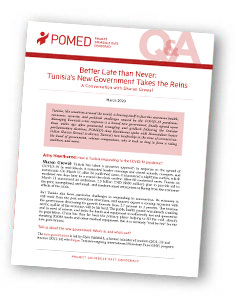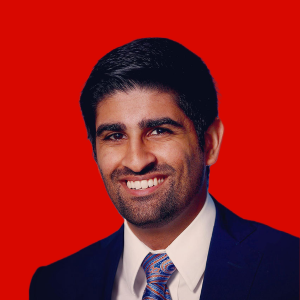 Tunisia, like countries around the world, is bracing itself to face the enormous health, economic, security, and political challenges caused by the COVID-19 pandemic. Managing Tunisia’s crisis response is a brand-new government, finally agreed upon late last month after protracted wrangling and gridlock following the October parliamentary elections. POMED’s Amy Hawthorne spoke with Nonresident Senior Fellow Sharan Grewal to discuss Tunisia’s new leadership in the time of coronavirus: the head of government, cabinet composition, why it took so long to form a ruling coalition, and more.
Tunisia, like countries around the world, is bracing itself to face the enormous health, economic, security, and political challenges caused by the COVID-19 pandemic. Managing Tunisia’s crisis response is a brand-new government, finally agreed upon late last month after protracted wrangling and gridlock following the October parliamentary elections. POMED’s Amy Hawthorne spoke with Nonresident Senior Fellow Sharan Grewal to discuss Tunisia’s new leadership in the time of coronavirus: the head of government, cabinet composition, why it took so long to form a ruling coalition, and more.
To read this Q&A as a PDF, click here.
For more on Tunisia’s new cabinet and the composition of its parliament, be sure to see the POMED fact sheet, “Four Months in the Making: Tunisia’s New Government.“
AMY HAWTHORNE: How is Tunisia responding to the COVID-19 pandemic?
SHARAN GREWAL: Tunisia has taken a proactive approach in response to the spread of COVID-19. In mid-March, it restricted border crossings and closed schools, mosques, and restaurants. On March 17, after 24 confirmed cases, it announced a nighttime curfew, which escalated two days later to a round-the-clock curfew. After 60 confirmed cases, Tunisia on March 21 announced an ambitious, 2.5 billion TND ($850 million) plan to provide aid to the poor, unemployed, and small- and medium-sized enterprises suffering from the economic effects of the crisis.
But Tunisia also faces particular challenges in responding to coronavirus. Its economy is still weak from the post-revolution downturn, and experts expect a coming recession with the government decreasing its growth forecast from 2.7 percent to 1 percent. The tourism sector, a pillar of the economy, will be hit hard. The public health system was already creaking and in need of reform, and lacks the funds and equipment to sufficiently test and quarantine its population. China has thus far been the primary player helping to fill the void, already donating 20,000 masks and other medical equipment. But it is certainly “trial by fire” for the new government.
Tell us about the new government. Who’s in, and who’s out?
The new government is led by Elyès Fakhfakh, a former minister of tourism (2011-13) and finance (2012-14) who began Tunisia’s ongoing International Monetary Fund (IMF) program in 2013. Fakhfakh’s nomination for head of government was surprising, given that his party, Ettakatol, did not win any seats in the 2019—or the 2014—parliamentary elections.[1] Fakhfakh assembled a coalition of six political parties as well as independent figures to serve in his government:
- The “Muslim democratic” party Ennahda (“The Rennaissance”), the largest party in parliament with 52 seats,[2] received six ministries: health, higher education, housing, local affairs, transport, and youth.
- The pro-revolution party Attayyar Ad-Democrati (“The Democratic Current”), with 22 seats, received three ministries: civil service and anti-corruption, education, and state and land affairs.
- The leftist party Harakat Echaab (“People’s Movement”), with 15 seats, has two ministries: commerce and employment.[3]
- Tahya Tounes (“Long Live Tunisia”), the party of the outgoing head of government Youssef Chahed with 14 seats, likewise has two ministries: environment as well as investment and international cooperation.
- Nidaa Tounes (“Call for Tunisia”) and El-Badil Ettounsi (“The Tunisian Alternative”), with three seats each in parliament, have one ministry apiece: parliamentary relations and tourism, respectively.
- Continuing a longstanding tradition, more than half of cabinet posts (53 percent), including the sovereign ministries (foreign affairs, finance, justice, interior, and defense), went to figures without a formal party affiliation.[4]
Unlike the other post-revolution Tunisian governments, Fakhfakh’s is closer to a majoritarian (simple 50+1 majority) than a grand coalition or national unity government. It gained the support of 59 percent of the parliament with 129 votes,[5] as opposed to the 71 percent received by the troika[6] government in 2011 or the 77 percent by the 2015 Nidaa Tounes-Ennahda grand coalition government.[7] This bodes well for developing a strong opposition, but could also make it difficult for the government to get its initiatives passed in parliament.
Most of the parties in Fakhfakh’s coalition consider themselves pro-revolution and anti-corruption, while the major parties representing the “anti-revolution” camp, Qalb Tounes and the Free Destourian Party (PDL), are in the opposition. Indeed, the first principle in the document underlying the coalition is a “commitment to the values of the revolution, to completing the achievement of its goals, and to consolidating the democratic path.” The new government is thus more ideologically coherent than the Nidaa Tounes-Ennahda grand coalition, at least in its political orientation toward the revolution and democratic consolidation.
But on other issues, even Fakhfakh’s relatively more aligned coalition will face internal disagreements and potential fractures, just as the Nidaa Tounes-Ennahda coalition did. There appears to be little agreement within the new government on major economic reforms such as restructuring the bloated public sector. Tahya Tounes and Harakat Echaab have already disagreed publicly, for instance, about whether the government should privatize state-owned enterprises. More generally, the inclusion of the leftist Harakat Echaab raises questions in light of its opposition to the IMF program that Fakhfakh himself started seven years ago.
Why did it take so long—four months—to form a government?
The slow process followed the timeline outlined in the 2014 constitution. After the parliamentary election results were finalized by the electoral commission in November, the party that won a plurality of seats, Ennahda, had two months to form a government. When its effort failed in January, President Kaïs Saïed then nominated Fakhfakh, who had one additional month to form his government. Had Fakhfakh failed, new parliamentary elections would have been triggered.
In its first pass at forming the government, Ennahda nominated Habib Jemli, a technocrat who had served as a junior minister for agriculture in the troika government. Although close to Ennahda, Jemli is not a formal member of the party; reportedly, Ennahda leadership had believed that a nominal independent would be more able to bring together diverse parties. At first, Jemli attempted to assemble the same coalition of pro-revolution, anti-corruption parties that Fakhfakh would put together. But Jemli faced a number of difficulties in these negotiations, among them the fact that these parties had internal divisions and lacked clear negotiating strategies. Moreover, many within these parties felt that regardless of the distribution of ministers under Jemli, the government would, in practice, be “a government of Ennahda,” despite Jemli’s supposed independence.[8] As a result, many calculated that they would have more influence under a nominee of President Saïed, who does not belong to any party and shares their secular, pro-revolution orientation.
As negotiations faltered, Jemli reached out to Qalb Tounes, a move that further undermined trust with his original coalition partners who staunchly opposed this ‘old regime’ party. Jemli ultimately proposed a cabinet entirely of (nominal) independents—to the satisfaction of none of the parties. When his proposed government came up for a vote in parliament on January 10, it failed, garnering just 71 votes, primarily from Ennahda and the conservative Islamist Karama coalition, 38 votes short of what was needed.
President Saïed then moved on to propose Elyès Fakhfakh, who enjoyed two major advantages over Jemli in government-formation negotiations. First, he was viewed not as the candidate of Ennahda, but rather the candidate of Saïed, who since his October election has been the most popular political figure in Tunisia with an approval rating above 80 percent. Second, Fakhfakh’s attempt was the last chance to form a government. Had he failed and new elections been triggered, many sitting MPs might have lost their seats. Opinion polls suggested that parties outside of the negotiations, especially PDL, would have gained strength in new elections.
But Fakhfakh’s negotiations also faced obstacles, the most important of which was Ennahda’s insistence on a national unity government that would include its political rival, Qalb Tounes. Despite the lackluster performance of the 2015-2019 unity government, Ennahda insisted again on unity, even pulling out of Fakhfakh’s negotiations just days before the deadline. Ennahda eventually backed down on this demand, however, and supported Fakhfakh’s narrower coalition, having been granted an additional ministry (transport) and the replacement of independents proposed for certain ministries. In the early morning of February 27, after a debate lasting 15 hours, the parliament approved Fakhfakh’s government with 129 votes.
So why did Ennahda push for a government that included Qalb Tounes, a party that it had so strongly and bitterly opposed in the 2019 elections and cast as a threat to Tunisian democracy?
Ennahda’s stated reason, similar to its explanation after the 2014 elections when it joined a coalition with its then-nemesis Nidaa Tounes, is that Tunisia’s challenges are so severe that they require unity among the political class. In particular, Ennahda’s leadership anticipates that reforms to the economy, which may require further austerity measures, will be more easily accepted by the Tunisian people if they are presented by a unified political elite. Similarly, selecting the members of the constitutional court—a new body mandated by the 2014 constitution but delayed by political gridlock—will require a two-thirds vote in parliament, a difficult task for a simple majority government. In addition, a unity government also allows each party to share the blame in case of failure.
But there is a deeper fear pushing Ennahda in particular toward unity, or “consensus” in Tunisian political parlance, one that I outlined in a recent paper with Shadi Hamid published by the Brookings Institution. Ennahda’s leaders fear that in the absence of consensus, political polarization will re-emerge and paralyze the country as it did in 2013, threatening the democratic transition and Ennahda’s very existence. In 2013, Tunisia had become severely polarized between the pro-revolution troika government led by Ennahda and an opposition led by Nidaa Tounes that included anti-Islamist and anti-revolution figures. Fakhfakh’s government is in some ways a re-creation of the troika: Fakhfakh himself used to be a leader of Ettakatol, while Tayyar’s secretary-general Mohamed Abbou (now minister of anti-corruption) used to be a leader of CPR. Fakhfakh’s government, like the troika, likely will contribute to polarization between a government led by pro-revolution forces versus an opposition made up of anti-revolution ones: in this case, Qalb Tounes and PDL.
Ennahda’s leaders are still scarred from the troika period, particularly the crisis of 2013, when polarization and political assassinations combined to stall the democratic transition and threaten its collapse. Ennahda at the time faced widespread calls for its dissolution based on alleged responsibility for those assassinations. Today, there are similar calls, especially by PDL leader MP Abir Moussi, for Ennahda’s dissolution based on accusations that it harbors a secret apparatus that played a role in those assassinations and facilitated the flow of foreign fighters to the Islamic State.[9] Thus, some of Ennahda’s leaders are afraid that severe political polarization could trigger a chain of events leading to the party’s repression and even dissolution.[10] This fear leads Ennahda to push much harder for national unity than any other party.
What has been the effect of the long delay in forming the government?
Youssef Chahed’s lame-duck government, in place for five months following the parliamentary elections, announced no major new initiatives, which left the economy stagnant. However, the popularity of the new president, Saïed, and the honeymoon period afforded to him allowed Tunisia to get through the long negotiation period without major protests or unrest.
But the delay may have shaped Tunisians’ views of the political system. Saïed’s popularity coupled with the parliament’s difficulty in forming a government may have fueled public support for shifting back to a presidential system—as existed during the dictatorship—rather than the semi-presidential system codified in the 2014 constitution. In two nationally representative, face-to-face surveys that I conducted with a Tunisian firm in September 2019 and January 2020, I found that support for a presidential system grew considerably, from 43 percent in September 2019 to 62 percent in January 2020.[11] This support is likely to increase further if the Fakhfakh government fractures or if the semi-presidential system is seen as hampering a quick, effective response to the coronavirus crisis.
How likely is such a shift?
President Saïed may be interested in restructuring the political system. After all, he campaigned on a quirky platform of abolishing parliamentary elections. Saïed proposed replacing them with a bottom-up approach in which elected local councils would send delegates to the parliament; councils could then recall delegates if deemed not to represent local interests adequately. The idea behind this system, which would require a revision of the constitution to implement, is to marginalize political parties and move toward a direct democracy style of governance.
At this point, Saïed has the popularity to initiate such a shift. He is by far the most popular political figure in Tunisia right now. The survey that my colleagues and I conducted in January suggests that 83 percent of Tunisians would support Saïed in changing the constitution (the survey did not specify in what way). But revising the constitution would require the support of two-thirds of parliament, and it is not at all clear that Tunisia’s political parties would accept a change that would greatly diminish their influence.
A more likely structural shift is to increase the electoral threshold for future parliamentary elections. The 3 percent threshold in the 2019 elections produced a highly fractured parliament with 21 parties and no party with more than 25 percent of seats. Recently, three of the largest parties—Ennahda, Qalb Tounes, and Karama—informally agreed on increasing the threshold to 5 percent[12] and a draft law to that effect has begun making its way through parliament. While a higher threshold may reduce the diversity of views in the parliament, it may make it easier to form governments in the future.
What issues do you expect the new government to prioritize?
Whatever the new government had intended, its first priority has now become combating the spread of the COVID-19 coronavirus. Once this threat subsides, however, I expect a major focus of the Fakhfakh government to be anti-corruption. This is the primary issue on which the coalition members agree. It is also popular with the public—it was a key issue that propelled the outsider Saïed to the presidency. Saïed drew his popularity on his non-corrupt image as a “Robocop” who would clean up the political class. Coalition members whom I interviewed in early March, however, did not yet have a clear idea on what an anti-corruption campaign would entail.
I also expect the new government to revive the issue of transitional justice, largely abandoned by the 2015-2019 unity government. As President Saïed has pushed for, the government will likely publish a final list of the protesters killed by security forces during the 2010-2011 revolution, with the families of the martyrs compensated and honored for their sacrifice. The government may also act on the Truth and Dignity Commission (IVD)’s 2000-page final report, submitted in 2019 after five years of intensive investigations into the files of 62,000 victims of human rights violations committed between 1955 and 2013. The government may implement some of the IVD’s proposed reforms to the security sector and help secure the attendance of the alleged perpetrators in the specialized criminal chambers set up to deal with transitional justice cases. The IVD submitted 174 of its cases to these chambers, and 30 trials are underway, though they have suffered from delays and a lack of cooperation from the Ministry of Interior.
The new ruling coalition also will focus on consolidating the democratic transition, such as by attempting to finalize the constitutional court. Four members are to be chosen by the parliament, with four apiece subsequently chosen by the president and the Supreme Judicial Council. The parliament recently announced a schedule for a vote on April 8 for the three remaining members it is supposed to select. (The previous parliament approved one member, in March 2018.) Each candidate must be approved by two-thirds of the parliament, which may be a tall task in this fractured assembly.
NOTES
1. Fakhfakh also ran in the 2019 presidential election, receiving just 0.34 percent of the vote in the first round. He resigned from Ettakatol after his nomination as head of government.
2. Ennahda’s parliamentary bloc includes its 52 MPs plus two independents: Chokri Belhaj Amara (from the independent list “El Khir” in Zaghouan) and Ahmed Belgacem (from the independent list “Young self-employed” in Gafsa). Both independents voted for the Fakhfakh government.
3. The 37 Attayyar and Echaab MPs jointly form a parliamentary bloc, called the Democratic Bloc, alongside four other MPs: Mongi Rahoui (Popular Front, Jendouba), Chokri Dhouibi (independent list “Citizenship and Development,” Tozeur), Faycel Tebini (Voice of Farmers party, Jendouba), and Adnan Hajji (Social Democratic Union, Gafsa). None of those four MPs, however, voted for the Fakhfakh government.
4. While nominally independent, many of these figures are seen as close to the coalition partners. An Ennahda MP estimated that 11 or 12 ministers are formally party members or informally connected to Ennahda (anonymous Ennahda MP, interview by the author, March 2020, Tunis).
5. Fakhfakh’s government won the support of 129 of 217 MPs: 52 of 54 MPs in the Ennahda bloc, all 37 Tayyar and Echaab MPs, 15 of 16 in the Reform bloc (led by Nidaa Tounes and El Badil Tounsi), 13 of 14 in Tahya Tounes, eight from the Mostakbal bloc, and four ex-Karama Coalition independents.
6. The troika was a governing coalition (2011-2013) of three pro-revolution parties: Ennahda, Congress for the Republic (CPR), and Ettakatol. Ennahda and CPR alone would have reached a simple majority.
7. If we instead use the number of parliamentary seats held by parties formally represented in the government, the numbers would be 55 percent (119 seats) for Fakhfakh, compared to 64 percent of seats held by parties represented in the troika government, and 82 percent held by parties in the Nidaa-Ennahda government in 2015.
8. MP Zied Ghanney (Attayyar), interview by the author, March 5, 2020, Tunis.
9. Just in the last month, the issue of investigations into Ennahda’s alleged secret apparatus was raised both by President Kaïs Saïed and MP Adnan Hajji.
10. Abdelhamid Jelassi, interview by the author, March 6, 2020, Tunis. Jelassi, a longtime Ennahda leader who disagrees with these assessments made by Ghannouchi and other leaders, announced his resignation from Ennahda on March 4.
11. The two surveys were conducted jointly with Robert Kubinec (NYU-Abu Dhabi) and Steven Brooke (University of Wisconsin-Madison) and implemented by One to One for Research and Polling. The first surveyed 1,000 Tunisians between September 10-14, 2019, while the second surveyed 1,200 Tunisians between January 11-24, 2020.
12. MP Oussama al-Sghaier (Ennahda), interview by the author, March 10, 2020. With Qalb Tounes’s fracturing (on March 10, it lost 11 of its 38 MPs, only two of whom have since returned), it is not clear if it would still support a higher threshold.





|
Consolidating Power: Tunisian President Kais Saied’s Crackdown on the Judiciary